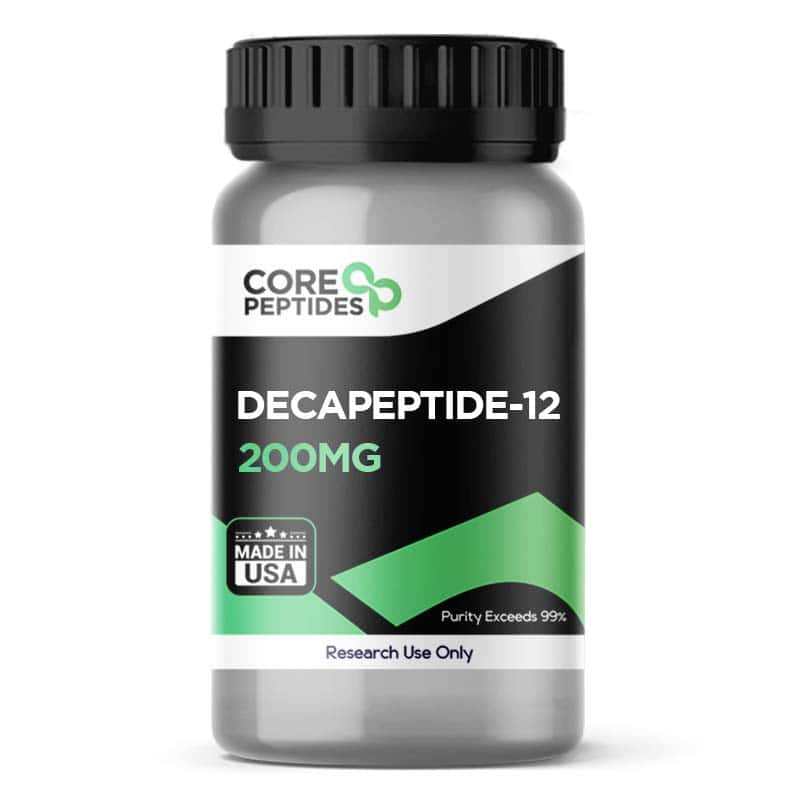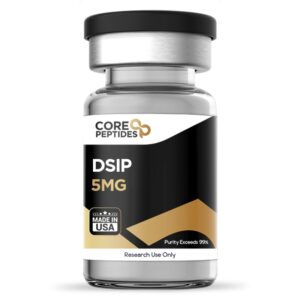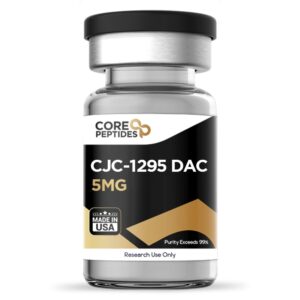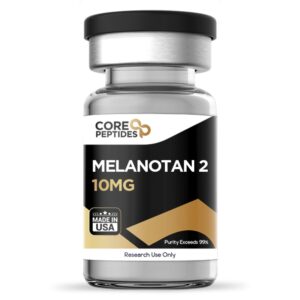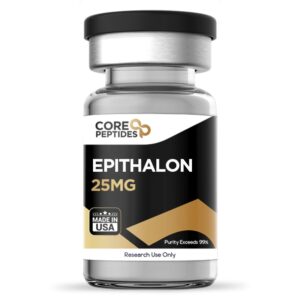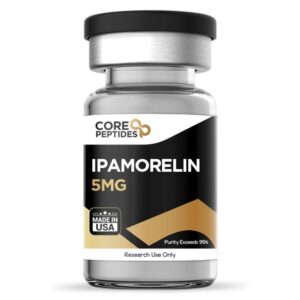Decapeptide-12 (200mg)
$240.00
Size: 200mg
Contents: Decapeptide-12
Form: Lyophilized powder
Purity: >99%
SKU: P-Decapeptide-12
FREE Shipping on $200+ orders
Discount per Quantity
| Quantity | Discount | Price |
|---|---|---|
| 5 - 8 | 5% | $228.00 |
| 9 + | 10% | $216.00 |
Decapeptide-12
Decapeptide-12 is a synthetic peptide that is composed of 10 amino acids. Its developers and subsequent researchers have suggested that Decapeptide-12 may potentially inhibit melanin production in the skin by suppressing the activity of tyrosinase, an enzyme involved in the synthesis of melanin.
Decapeptide-12 does not appear to mimic any naturally occurring peptide. Rather, it was designed and synthesized to exhibit specific properties. Decapeptide-12 is primarily researched in reducing melanin production and hyperpigmentation. It has also been studied for its potential impact on cell growth, differentiation, and mitigating cell aging. However, more research is needed to fully understand the potential properties and results of Decapeptide-12 experiments in these contexts.
Chemical Makeup
Molecular Formula: C65H90N18O17
Molecular Weight: 1311.46 g/mol
Overview and Mechanisms of Action
As mentioned, Decapeptide-12 is posited to work primarily by inhibiting melanin synthesis, aka melanogenesis. Melanin synthesis is suggested to be a complex biochemical pathway that may occur within specialized cells in the skin called melanocytes. Tyrosinase is posited to play a pivotal role in this pathway as it appears to catalyze the first two steps in melanin production: the hydroxylation of tyrosine to DOPA (3,4-dihydroxyphenylalanine) and the oxidation of DOPA to DOPAquinone. These reactions are suggested to be essential for the subsequent production of eumelanin and pheomelanin, the two main types of melanin pigments that determine skin, hair, and eye color and may protect against UV radiation. As mentioned, Decapeptide-12 may act by potentially inhibiting tyrosinase activity. While the precise molecular mechanisms are complex and involve multiple pathways, the basic understanding is that Decapeptide-12 may bind to specific sites on the tyrosinase enzyme or its mRNA, thereby blocking the enzyme's ability to catalyze the aforementioned critical reactions in melanin synthesis. This inhibition could occur through direct interaction with the enzyme, leading to a change in its conformation and reducing its catalytic efficiency. Alternatively, Decapeptide-12 might interfere with the enzyme's gene expression, lowering the amount of functional tyrosinase produced in the melanocytes.
Research and Clinical Studies
Decapeptide-12 and Melasma
One clinical study aimed to evaluate the potential of Decapeptide-12 in test subjects with moderate to severe melasma, solar lentigines, periocular lines, and wrinkles.(1) This 24-week experiment reported apparent improvements in all of the reported facial conditions among the 25 subjects, with sustained impact.
Another clinical trial investigated the potential of Decapeptide-12 on mild-to-moderate melasma in 33 test subjects over 16 weeks.(2) Results suggested a visible reduction in the appearance of melasma.
Furthermore, one study reported a complete clearance of melasma in 25% of subjects after six weeks of Decapeptide-12 presentation.(3) Decapeptide-12 also was reported by the researchers to exhibit an apparent impact in test subjects with the Fitzpatrick phototype IV skin type and moderate recalcitrant melasma completed.(4) Subjects with Fitzpatrick skin type IV are reportedly some of the most common melasma sufferers. The researchers concluded that: “All […] demonstrated statistically significant improvement in the appearance of melasma and overall facial aesthetics.”
Decapeptide-12 and Post-inflammatory Hyperpigmentation
A clinical case study on pigmented skin (Fitzpatrick skin type IV) indicated that Decapeptide-12 may possibly accelerate the clearance of post-inflammatory hyperpigmentation compared to placebo.(5) The researchers suggest this might be due to the tyrosinase-inhibiting potential of Decapeptide-12.(6)
Decapeptide-12 and Solar Lentigo
One study evaluated the impact of Decapeptide-12 in the form of hyperpigmentation called solar lentigines caused by chronic photodamage.(7) The results reported that 38.5% of the models evaluated appeared to have achieved complete clearance, and all subjects appeared to exhibit some improvement. Furthermore, 30.7% of the models were reported to improve from a moderate degree of photodamage to a milder degree, 15.4% improved from a severe degree to a moderate degree, and another 15.4% improved from a severe degree to a milder degree after 24 weeks.
Decapeptide-12 and Cell Aging
Sirtuins are a family of genes involved in various cellular processes. They are believed to regulate cellular metabolism, DNA repair, inflammation, and stress resistance. One of the most well-known sirtuins is SIRT1, which has been suggested to regulate various biological pathways, such as glucose metabolism, lipid metabolism, and cellular stress responses. Studies have also suggested that SIRT1 may be involved in extending the lifespan in certain model organisms. One of the most promising compounds is resveratrol, found in red wine, and has been suggested to activate SIRT1 in some studies.
One study looked at the potential of Decapeptide-12 on sirtuin gene expression levels in keratinocyte progenitors.(8) The researchers used RT-PCR to measure the impact of Decapeptide-12 on seven Sirtuin genes and cellular viability and proliferation after 72-hour incubation with various concentrations of Decapeptide-12. The results suggested that Decapeptide-12 possibly increased the transcription of several Sirtuin genes, including SIRT1, SIRT3, SIRT6, and SIRT7, with reportedly reduced cytotoxicity. The researchers reported that “ decapeptide-12 increased transcription of SIRT1 by 141 ± 11% relative to control cells, whereas levels of SIRT3, SIRT6, and SIRT7 were increased by 121 ± 13%, 147 ± 8% and 95± 14%, respectively.”
SIRT1, with a reported increase in transcription by 141 ± 11% may enhance cellular resilience against oxidative stress and inflammation, possibly delaying aging processes on a cellular level. The apparent increases in SIRT3 (121 ± 13%) and SIRT6 (147 ± 8%) transcription levels further amplify the possible research outcomes. SIRT3's potential involvement in mitochondrial function and energy metabolism suggests that decapeptide-12 might enhance mitochondrial efficiency and antioxidant capacity. Similarly, SIRT6 is possibly associated with DNA repair, telomere maintenance, and inflammation regulation. Its potential upregulation might contribute to improved genomic stability and reduced inflammation, potentially further decelerating the aging process in cells. While the reported increase in SIRT7 transcription (95 ± 14%) appears less pronounced, it may still indicate potential influence on nucleolar functions, including ribosome biogenesis and stress sensing. This subtle modulation might also contribute to the overall cellular homeostasis and longevity.(8)
Decapeptide-12 is available for research and laboratory purposes only. Please review and adhere to our Terms and Conditions before ordering.
References:
- Jiang, L., Hino, P. D., Bhatia, A., Stephens, T. J., & Jimenez, F. (2018). Efficacy of Trifecting® Night Cream, a Novel Triple acting Skin Brightening Product: A Double-blind, Placebo-controlled Clinical Study. The Journal of clinical and aesthetic dermatology, 11(12), 21–25.
- Ramírez, S. P., Carvajal, A. C., Salazar, J. C., Arroyave, G., Flórez, A. M., & Echeverry, H. F. (2013). Open-label evaluation of a novel skin brightening system containing 0.01% decapeptide-12 in combination with 20% buffered glycolic acid for the treatment of mild to moderate facial melasma. Journal of drugs in dermatology : JDD, 12(6), e106–e110.
- Hantash, B. M., & Jimenez, F. (2012). Treatment of mild to moderate facial melasma with the Lumixyl brightening system. Journal of drugs in dermatology : JDD, 11(5), 660–662.
- Hantash, B. M., & Jimenez, F. (2009). A split-face, double-blind, randomized and placebo-controlled pilot evaluation of a novel oligopeptide for the treatment of recalcitrant melasma. Journal of drugs in dermatology : JDD, 8(8), 732–735.
- Bhatia, A., Hsu, J. T.s, & Hantash, B. M. (2014). Combined delivery and dermalinfusion of decapeptide-12 accelerates resolution of post-inflammatory hyperpigmentation in skin of color. Journal of drugs in dermatology : JDD, 13(1), 84–85.
- Chen, J., Bian, J., Hantash, B. M., Albakr, L., Hibbs, D. E., Xiang, X., Xie, P., Wu, C., & Kang, L. (2021). Enhanced skin retention and permeation of a novel peptide via structural modification, chemical enhancement, and microneedles. International journal of pharmaceutics, 606, 120868. https://doi.org/10.1016/j.ijpharm.2021.120868
- Kassim, A. T., Hussain, M., & Goldberg, D. J. (2012). Open-label evaluation of the skin-brightening efficacy of a skin-brightening system using decapeptide-12. Journal of cosmetic and laser therapy : official publication of the European Society for Laser Dermatology, 14(2), 117–121. https://doi.org/10.3109/14764172.2012.672745
- Basil, M. H., & Anan, A. U. (2019). Tyrosinase inhibitors with potent anti-senescence activity in human neonatal keratinocyte progenitors. J Dermatol Surg Res Ther, 2019, 30-39.
